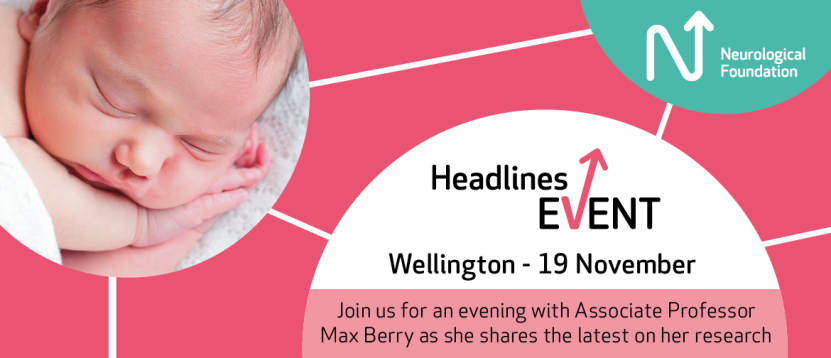Babies matter! But how do we safeguard the neurodevelopmental potential and systemic wellbeing of our smallest and most vulnerable patients? As a Neonatal Intensive Care specialist this is a question that confronts me daily – we care for some of New Zealand’s smallest and sickest patients yet the challenges, and the triumphs, of perinatal medicine are not as widely understood as we would like.
Children born too early face an inequitable future with little available to families or clinicians to actively address their specific needs, and even less specifically designed to safeguard long-term wellbeing. Prematurity creates a vast and underappreciated legacy, with profound implications for the individual, their family and more widely, for society. It casts a shadow across all facets of health (including neurodevelopmental, cardiovascular, metabolic, reproductive), educational and economic wellbeing.
Increasingly we are starting to understand that any reduction in gestation length has adverse implications. We’ve shown how even moderate preterm birth is linked to evidence of ADHD-type behaviours in the pre-school years, a need for increased learning support in classrooms and poorer NCEA performance in adolescence. With one in twelve Kiwi babies born preterm, we need to continue to develop innovative ways with which to optimise brain development to ensure that the early life adversity arising from premature birth doesn’t continue to dominate their childhood and adult life.
The fetal and early newborn period are times of incredible growth and development. This both increases vulnerability to environmental insults (e.g. preterm birth) but also provides opportunity for therapeutic intervention. Early intervention during windows of developmental ‘plasticity’ can change the trajectory of neurodevelopmental impairment back to one of optimal function. Waiting until disease manifests before intervention is too late; rather than providing the ambulance at the bottom of the cliff, our research is predicated on moving early to re-set an adverse trajectory and protect optimal function and wellbeing.
Preterm babies are born during what should be the last weeks, or even months of fetal life. A baby born at the cusp of human viability weighs around 500g; their brain is still a very simple structure with a relatively low surface area to volume ratio. By term, a baby is on average seven times heavier at 3500g, with a brain that although immature compared to an adult, is now a complex structure with well-developed sulci (grooves or furrows on the surface of the brain) and gyri (ridges or folds between two clefts on the cerebral surface of the brain). The conditions experienced by a preterm infant are far removed from the environmentally and physiologically protected intrauterine conditions experienced by a fetus of the same postconceptional age. In particular, the preterm baby does not receive the growth factors, hormones, nutrients, and other factors provided by both the mother and the placenta that are thought to be key to successful fetal organ maturation. For the preterm infant therefore, this phenomenal increase in both size and complexity of the brain must happen in a relatively unsupported ex-utero environment that bears little resemblance to the conditions in utero. Understanding the impact of this ‘preterm deficit’ underpins the mechanistic characterisation of preterm-associated morbidity and is essential for the development of targeted therapies.
We’ve developed a unique model of induced preterm birth in guinea pigs that allows us to explore adjuvant therapies designed specifically to restore some of the key factors that a fetus requires, but a preterm baby does not currently receive. Like preterm-born humans, guinea pigs born preterm have an altered behavioural state as they grow up that mirrors the hyperactivity seen in children, especially in males, with evidence of altered myelination and oligodendrocyte maturation (the cells that insulate nerves with myelin). Through utilisation of this clinically relevant animal paradigm we can conduct detailed mechanistic studies into the life-course functional disruption incurred through preterm birth and explore potential mitigation strategies. This data will in turn provide crucial efficacy and safety data necessary to inform translational studies in human preterm infants.
The Neurological Foundation is supporting our research into the therapeutic potential of neurosteroid replacement following preterm birth. The placentally derived hormone progesterone is converted by the fetus into the neurosteroid allopregnanolone, which has neurotrophic and neuroprotective effects as well as gliotrophic effects (development of cells that support neurons) in fetal life. The levels of allopregnanolone in the fetal brain are high but fall rapidly after birth consequent on the separation of the newborn from their placenta. Mechanistically, allopregnanolone binds to the unique neurosteroid site on the GABA-A (gamma-aminobutyric acid) receptor thus increasing the neurotransmitter effects of GABA action at its receptor. GABA-A receptors are widely expressed on oligodendrocyte precursors with GABA activation necessary for their maturation; its therefore plausible that the delayed myelination and white matter changes seen in the ex-preterm population fundamentally reflect a disruption to neurosteroid-mediated coordination of oligodendrocyte activation and maturation.
Unfortunately though, it’s not as simple as providing preterm infants with either exogenous progesterone to match their fetal ‘equivalent’ exposure profile or allopregnanolone itself. Although both options have been explored experimentally, there are problems with steroid pathway activation and bioavailability that limit therapeutic potential. Instead, we have identified Ganaxolone as a long-acting allopregnanolone analogue that, like allopregnanolone itself, acts at the steroid site on GABA-A receptors to increase the effects of GABA activation. Unlike allopregnanolone, Ganaxolone has a long half-life (>5 hours) so it can be delivered by intermittent dosing, again increasing its potential translation into clinical practice.
Our preliminary data suggest that juvenile guinea pigs born preterm and treated with Ganaxolone between birth and the term equivalent age (their “due date”) have functional recovery of the hyperactivity-like behaviour found in preterm animals, returning to a much more term-like behavioural state. Similarly, with Ganaxolone treatment, myelination in key areas of the brain looks more like that of a term-born animal than one born preterm.
These proof-of-concept translational studies are key to making a meaningful change to the neurodevelopmental outcomes experienced by preterm infants. Through using clinically relevant animal models to understand the mechanistic basis of preterm-associated neurodevelopmental disease we can start to lessen the life-course impact of gestational age at birth. Protecting the brain, and supporting its growth and maturation during windows of developmental plasticity may allow individuals born preterm to enjoy the same long-term health and wellbeing as their term-born peers, thus mitigating the life-course inequity resultant on gestational age at birth.
Associate Professor Max Berry
Associate Professor Max Berry obtained her BSc in Developmental Neurobiology from the University of London prior to completion of undergraduate medical training at Guy’s and St Thomas’s Hospital, London. She obtained MRCPCH (Membership of the Royal College of Paediatrics and Child Health) in the UK just before emigrating to New Zealand, where she completed her training in neonatal and perinatal medicine in Hamilton and Wellington. In 2008 Dr Berry was awarded an HRC (Health Research Council of New Zealand) Fellowship for PhD studies; during her PhD she examined the long-term effects of preterm birth, early nutrition, and antenatal corticosteroid exposure on cardiometabolic outcomes in sheep. Dr Berry received a project grant from the Neurological Foundation in 2018 to investigate behavioural and neurodevelopmental disorders in children and adolescents born preterm.








